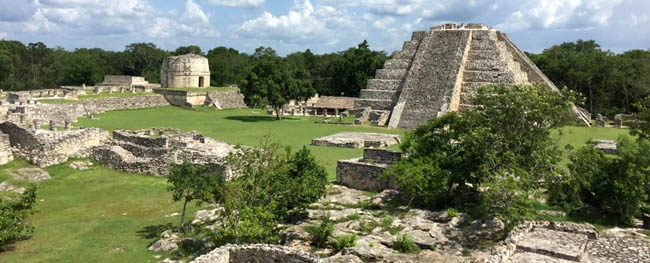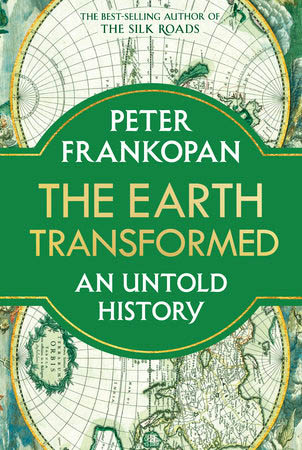
The collapse of the Mayan Empire is often attributed to climate change. In ‘The World Transformed,’ historian Peter Frankopan offers a more nuanced account of the links between environmental and social change.

Peter Frankopan
THE EARTH TRANSFORMED:
An Untold History
Penguin Random House, 2023
reviewed by Martin Empson
Faced with climate chaos, writers are looking at humanity’s past to understand how environmental changes influenced our ancestors. Many who’ve taken this approach are looking for clues about how we might survive our own catastrophe. But, too often, such histories suffer because they present a direct link between environmental change and the fate of civilizations.
Peter Frankopan’s The Earth Transformed mostly avoids this trap. We get a sense of this from the introduction where he writes that his purpose is not to predict the future. It’s to “look at the past and to understand and explain how our species has transformed the earth to the point that we now face such a perilous future.”
He set out to write a history to explain “what an important role climate has played in global history.” But, instead, by “opening the door to climate” and “human intervention in the natural world” he began to think about the origins of the state and the links between different types of society — nomadic, pastoralist and sedentary.
This broad approach means that the book is a truly global history. He examines how societies related to environmental change and natural disaster, and how the environmental context shaped events themselves. This might not seem like new ground. There are plenty of books that examine how historical societies coped, or failed to cope, with natural changes.
Many writers, for instance, have argued about why the Maya civilization in central America seemed to collapse in the 17th century. Some argue it was due to climate change, others to overpopulation or warfare. Frankopan’s explanation gives an indication of his more nuanced approach.
“What collapsed was not the Maya world as a whole, but rather the skeleton that held it up — the mesh of networks that linked locations together, facilitated the exchange of goods and ideas, and provided a canvas for alliances, rivalries and competitive kingship. Faced with drought, crop shortages and loss of mechanisms of control, rulers found it impossible to meet expectations and maintain authority.”
In other words, understanding the impact of environmental change on society means studying how that society functions. It is not enough to look at causal links. Environmental change might cause a drought, which can lead to starvation and then death on a huge scale. But as an explanation for the collapse of an entire complex society this is rarely enough. Instead, we must examine how a society reacts to these changes.
We see this again when Frankopan discusses the Akkadian empire around 2300 BCE. The ruler, Sargon, built a huge empire in Mesopotamia in the Middle East. A few decades after Sargon’s death his grandson faced a major rebellion. A famous ancient text called The Curse of Akkad describes a horrific social collapse — drought and famine brought about by climate change which led to the failure of cities, mass movements of refugees and war. Frequently this is used as a salutary lesson in how the failure to deal with climate change will lead to the end of civilization.
But Frankopan cautions us not to see too direct a link. What mattered was how Akkadian society responded to the crisis. “It did not take much for a precarious balance to be upset,” he explains.
“A single bad harvest could cause problems that included not only famine but political turbulence and social upheaval. And in that sense the crucial question should not be what were the effects of a substantial change in climate around 2200 BC, but rather what steps were taken to mitigate the challenges that this posed.
“What mattered, in other words, was whether rules, elites, priests, bureaucrats and workers could adapt, not least to rising environmental pressures, and whether those choices and steps were appropriate and effective. It was not so much that climate brought down the Akkadian empire as that the Akkadian empire collapsed under its own weight.”
In addition, Frankopan points out that different classes in society experience events differently. “It can be tempting to focus on large-scale architecture, symbols of royal power and the powers of the bureaucracy and to correlate their disappearance and reduction with societal failure,” he writes. “It is perhaps more useful to question how life changes in practice for agricultural workers, women, children and families.”
Indeed, those at the bottom of society might experience the political center’s collapse as a “liberation of sorts.” Frankopan is not suggesting that environmental-driven social collapse will be good for workers and peasants. Quite the opposite. “The burden of calamity falls disproportionately on the poor,” he says. Rather, he is showing how the experience of climate crisis will manifest through all the fractures and fissures in society.
Class, for Frankopan, plays a key role in understanding societies under the impact of external shocks from environmental change. He argues that the “decisive factor in vulnerability to socio-economic stress and famine” is the proportion of a particular society who are poor.
Unfortunately, the nuance of Frankopan’s analysis of ancient society is less evident in the sections on the modern world. His treatment of the development of capitalism is oversimplified. There is a tendency to see capitalism as arising out of a series of choices made by individuals rather than the gradual development of the forces of production. This created a class of individuals who saw their economic future in a new way of organizing society.
This is exemplified by the author’s treatment of the French Revolution of 1789. Following the themes of the book, he emphasizes the importance of the harvest failures in producing discontent at the base of French society. These rebellions provided triggers for the French Revolution. But, in and of themselves, they are inadequate to explain the way that sections of society were willing to lead a revolution against the monarchy and establish a new social order.
Frankopan emphasizes the role of new ideas at this point in history, but fails to locate them in any emerging economic relations. He writes that for the philosopher Hegel “the urge to ‘do violence’ to nature was an aggressive statement that reflected emerging mainstream ideas, bundling whiteness, power and entitlement into a toxic framework that set Europeans at the apex of humankind and of all living animals”.
Nature, Frankopan continues, “became something to be not only exploited” but seen as something “standing in the way of human progress.” There is much truth in these comments, but nature in this worldview has been abstracted from material reality. Much clearer, in my view, is Karl Marx’s comment that for the capitalist class, nature was a “free gift to capital”. In other words, under capitalism the environment became wedded to an economic system of production that cared only for the accumulation of wealth.
This isn’t to say that Frankopan’s work on more modern society is without value. Quite the opposite. I wish that every work of environmental history had as detailed a consideration of the role of the slave trade in the birth of capitalism. Frankopan explores the reality of slavery and considers what this meant for the American and Western African environments. Plantation slavery sucked the land dry of nutrients, destroyed ecologies and left millions dead. Africa itself was robbed of people and raw materials, a legacy that continues to cause suffering for millions today.
It is just one example of how the drive to maximize wealth by the capitalist class leaves destruction, ecological disaster and immense suffering in its wake. For Frankopan, capitalism is a system that sees the “conjunction of the search for profits, the unsustainable exploitation of the landscape and nature taking revenge when pushed beyond its limits.”
Despite Frankopan’s awareness of the nature of capitalism and the realities of colonial and imperial history, I found the final section of the book inadequate. In part, this is because his focus in the 20th and 21st centuries becomes much more narrowed on the superpowers’ role in shaping ecological and social history. This means that the breadth of coverage that was such a strength in the first part of the book is missing.
But the biggest problem is that the final section has little sense of the struggle against capitalism’s degradation of nature and exploitation of people. This is not to say the author ignores resistance completely. For instance, he covers the Haitian Revolution of 1791-1804 that ended slavery in France’s former colony.
But, Frankopan’s treatment of the Russian Revolution of 1917 is inadequate. He draws a lazy continuity between the revolutionary era and the Stalinist counter-revolution. This conflation of events allows Frankopan to argue that revolutionary Russia had a negative approach to the natural world as the capitalists did. It is fairer to argue that many revolutionaries, including Vladimir Lenin, had great concern to protect the natural world. But they were limited in their ability to act on this by the immediacy of civil war.
Frankopan fails to get to grips with the great social movements that have the power to challenge—and potentially overturn — capitalism. This means his conclusions are quite cynical. His account of the current environmental crisis is comprehensive and frightening, not least in his awareness of the failure by governments to act. But, because he doesn’t see struggle as an avenue for changing the world, he sees little hope. He notes, dryly, “Much of human history has been about the failure to understand or adapt to changing circumstance.”
Some cynicism is perhaps understandable. Frankopan is aware that capitalism is a global system that has unleashed a truly global ecological disaster. His book highlights how, in humanity’s past, environmental disaster tended to be more localized. Civilization collapse or setback tended to be a local event. Today we face global disaster.
We should be mindful of the main lesson of his book. Humanity is not doomed to repeat the “Curse of Akkad”. In the face of disaster, it matters what people in society do — what steps they take to mitigate environmental destruction and protect lives.
Capitalism is unable to take those steps because of how the system’s central dynamic — capital accumulation—relies on the systematic degradation of nature. But capitalism also breeds resistance. And recent years have seen movements of millions of people challenging the status quo, and fighting for a different world.
The greatest strength of Frankopan’s book is a sense that humanity has developed a multitude of different ways of relating to the wider natural world, and in doing so, has proven that we are not inherently destructive of the environment. Catastrophe is not automatic.
Socialists will want to go further. Capitalism cannot solve the ecological crises. That will require a revolutionary transformation in how we relate to our environment. While The Earth Transformed does not make this argument, there is plenty of material in it to inspire, encourage and make us think about our ecological relationships.
Martin Empson blogs at Resolute Reader. This review was first published on the SWP (UK) website.



Might I point out the excellent work of John Bellamy Foster found regularly in Monthly Review, New York. His “Engels’s Dialectics of Nature in the Anthropocene ” is an important text in providing insights to the historical foundational intellectual traditions of revolutionary understanding of ‘ capitalism myopic drive to accumulation ad infinitum with its innate uncontrollability and neglect of environmental consequences.’